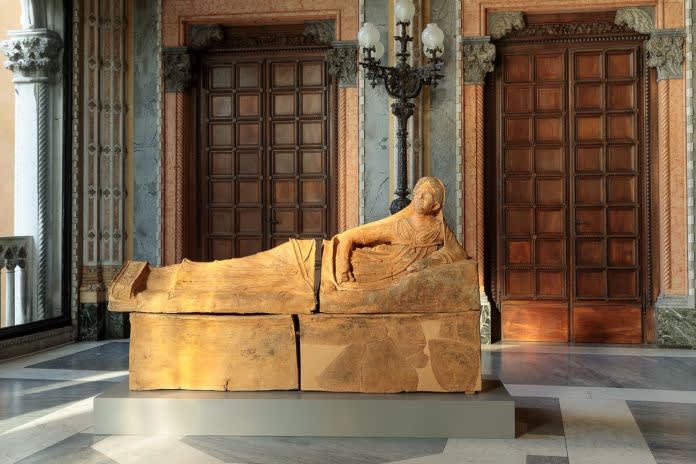ON EXHIBITION AT PALAZZO FRANCHETTI THE WORLD OF THE ETRUSCANS AND THAT OF MASSIMO CAMPIGLI. AN INTIMATE AND DEEP DIALOGUE BETWEEN THE WOMEN-HOURGLASSES AND THE WOMEN-AMPHORAES OF THE ARTIST, MYSTERIOUS AND IMPASSIBLE, WITH THE ETRUSCAN FINDS THAT AROVE HIM A PAGAN HAPPINESS.

Massimo Campigli and the Etruscans. The pagan happiness. Exhibition view at ACP Palazzo Franchetti, Venezia 2021. Photo Francesco Allegretto.
In the exhibition set up in Venice in the spaces of Palazzo Franchetti (whose management is entrusted to ACP - Art Capital Partners, a company closely linked with the Galleria d'Arte Maggiore in Bologna), the curators Franco and Alessia Calarota underline the profound dialogue between thirty-five works by Massimo Campigli (Florence, 1895 - Saint-Tropez, 1971) with about fifty finds dating back to the Etruscan period, with which the artist shares atmospheres, signs, colors, emotions. The compositions, clearly archaic, range from 1928 to 1966.
Many of the testimonies of the Etruscan civilization are unpublished and exhibited here for the first time, the result of kidnappings and restitutions. They are forms that represent votive statues. Female figures with busts / hourglasses immersed in the timeless dimension of abstraction. Inspired by these expressive profiles, Campigli obtains that particular painting, that highly original compositional cut where time loses depth. And it is like living in an impassive stillness, where space is invaded by amphora women.
THE WOMEN-AMPHORA OF CAMPIGLI
Campigli's exegetes often dwelt on his attention to women, so decisive for his creative universe. Without ever considering it, with very few exceptions, a sexual object. Note the elegant compositional strategies that Campigli uses, within which the signs used convey subtexts with multiple meanings: the necklace as a jewel and as a chain, the diabolo as a cord and as a link, the railing as an embellishment and as a railing. The exhibition focuses on the artist's relationship with the other half of the sky, with women who become hourglasses, elegant in their jewels. Female figures rendered through geometrical schemes that differ in colors and gestures, assuming vaguely unreal aspects. All visions that unleash a pagan happiness in Campigli, as he describes it, after visiting the Etruscan Museum of Villa Giulia in 1928: "In my paintings a pagan happiness entered both in the spirit of the subjects and in the spirit of the work that became freer and freer. lyric ".

Massimo Campigli, Veiled women, 1943, oil on canvas, 66×48 cm. Private colllection, Bologna
